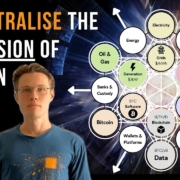The Physics-Maths & Finance of BTC | Hashpower Academy
Welcome to Hashpower Academy, where we unravel Bitcoin’s core. In “The Physics, Maths, and Finance of BTC,” we dive into the science and systems driving the world’s top crypto.
What’s Covered:
Physics: Energy powers Bitcoin—mining turns watts into coins.
Maths: Compute solves the puzzle—hashpower secures the network.
Finance: BTC redefines money—value backed by work, not trust.
How they connect: Energy fuels compute, compute creates finance.
Bitcoin’s brilliance: A system balancing all three.
Key Insights:
Energy: Every block needs real-world power—physics sets the cost.
Compute: Math keeps it fair—difficulty adjusts the challenge.
Finance: 21 million cap ties value to scarcity and effort.
Unified design: Satoshi baked these laws into BTC.
Why It Matters:
Bitcoin’s not just digital—it’s a physical, calculated economy.
Understand this trio to grasp BTC’s true strength.
Join Hashpower Academy to decode the physics, maths, and finance of BTC—watch now and see Bitcoin’s foundation!
Financial Disclaimer:
This video serves educational and informational purposes only and should not be construed as financial advice or investment recommendation. The views expressed are those of the presenter and do not represent Hashpower Academy’s official stance. Information is provided ‘as is’ without warranties, express or implied, as to its accuracy or completeness. Engaging with Bitcoin involves high risk, including potential financial loss, market volatility, and energy costs, and is suitable only for those who can bear these risks. Always conduct your own research and consult with a qualified financial or technical advisor before making decisions related to Bitcoin.
#Bitcoin
#Energy
#Compute
#Finance
#Crypto
#Mining
#Blockchain
#Physics
#Maths
#Money
#Hashpower
#Power
#Tech
#Investing
#Economy
#EnergyUse
#Computing
#FinancialTech
#BTC
#CryptoMining
Video Transcript:
hello there and welcome to another episode from the hash power Academy this is where we discuss anything and everything related to bitcoin and its underlying Network and fundamentals of physics maths and finance and that is exactly the topic of today that is to say that the entire Bitcoin Network can be extrapolated into three core areas of energy compute and finance that is the producer and commodity of energy energy systems such as solar wind Hydro gas coal what do they all produce they all produce the same fungible commodity of electricity and it’s of fundamental importance to the 21st century so let’s just put kilowatt hours here microchips Hardware the technology aspects of compute power what does it all produce whether it’s your CPU GPU or Asic the the timeline the lifespan of these sorts of machines is quite shortlived but the The Innovation curve is continually accelerating to make denser and denser microchips is it important that we have microchip technology in the 21st century it’s a fundamental importance and in the context of Bitcoin it produces this processing power we call sh 256 hash rate and these sorts of things we all can condense down to a performance of Terra hases a trillion bhes per second these are the these are the units and the time time aspects in relation kilowatt hours and teres per second and Bitcoin in of itself Timeless monetary units produced by energy and compute the unit of account now these three core Commodities have their technologies that produce them energy hard infrastructure compute hardware and the blockchain where Bitcoin comes from and what you get is this Dynamic that the energy energy technology is producing energy Bitcoin mining is consuming that energy and in the process it produces hash rate and the Bitcoin blockchain is essentially consuming that hash rate and what does the Bitcoin blockchain do it issues every block a certain amount of subsidy of Bitcoin into circulation until the full 21 million units of Bitcoin are are produced in 100 plus years from now for the full Supply to be issued and what do people do with Bitcoin when they transfer it they pay a fee so there is an aspect of consumption of their Bitcoin and that is the first utility use case of Bitcoin now what you get is this flowing series of energy and finance connected through a communication system of compute compute in fact is that bridge between the two worlds and it’s the reason I called it the hash power Academy and yeah all of these different pieces have a fundamental physics underneath this isn’t all arbitrarily connected through just Finance it’s through physics Finance justifies its initiation from humans creating and building all of this stuff and connecting it all together but it’s the physics that make it all work so let’s just run through the physics examples so we produce power kilowatt produce kilowatt hours transfer of that power over time we convert that power uh into hash rate and that conversion is considered jewles per terahash so as those electrons run through the microchips performing trillions of hash functions a second so we measure it in teres per second as mentioned and all of that compute power is being compared to the entire Collective compute power and the Bitcoin software is looking at how much uh compute power is producing blocks proof of work as a way of regulating its own time series so other people refer to the Bitcoin blockchain as a Time chain because it has these aspects of regulating the energy input to produce blocks which changes the rate of time that blocks are produced and the difficulty adjustment constrains energy and time and the rate of blocks being mined comput space it’s all weird and wonderful but we’ll take it through the mathematical series and what can essentially be boiled down to as the individual side of this versus the collective network is the amount of Bitcoin that you can earn per terahash per day so this this all encompasses the amount of Bitcoin you’ll be earning with your hardware and your electrical consumption to prove your work and the majority of people are sending their compute power and selling it to a mining pool at roughly the same rate and there’s all different payout options for this but that’s not the topic of today’s video so the output here is obviously BTC and the consump side is per virtual bite if you uh do want to spend it and so you’ve got settlement space in the world of global Finance connected to local energy production and transfer of energy through compute power in the middle so energy compute and finance all interconnected with hard hardcoded physics a computer is powered by energy producing Brute Force compute power to crack the next block in the chain and instead of attacking the network it’s paid to protect the network in in essence because the collective compute power is what creates the difficulty adjustment if 10% more hash rate comes online then roughly the difficulty adjustment raises by 10% this constrains the rate of issuance of Bitcoin per block and so all of this uh physics has a maths example that we can run through and a finance example that it’s connected to so let’s take you through the maths example first let’s just say you run one kilowatt you want run one kilowatt hour through a computer with say 20 Jew per terahash of conversion efficiency and you’re producing a certain amount of hash rate we’ll get to this in a minute and you’re going to be earning a certain amount Bitcoin uh which provides you also a certain amount of block space if you’re producing your own blocks so one kilowatt is 1,000 Watts divided by 20 so you get 50 terahash so you’re you’re buying say 1 kilowatt hour of energy converting it into 50 trashes of compute power through the computer and your 50 terahash is currently being compared to a Global Network of roughly 800 milli million terahash so you’re getting uh 50 shares of 800 million shares shall we say as an easy way to understand it of the global rate of Bitcoin issuance which is the amount of blocks per day as the as the rate of issuance and if you’re in a mining pool they’re just going to sell you that Bitcoin at a certain amount of Bitcoin per terahash today per day and yeah you’re going to get a quantity of Bitcoin on the other end but uh we could show this example in a very small minuscule not amount of Bitcoin or we can run through it in a more finance and dollarized World which will last for now but let’s run through a normal example let’s say you that one kilowatt hour you’re buying at 5 Cent so .05 and that’s costing you that is your cost your energy input and you’re converting it through a machine mean that if it’s 20 Jews per terahash it’s probably too much but I’m going to use $20 as the example $20 per terahash but you’re producing 50 terahash of compute um and well you’re essentially converting it into say well the amount of Revenue per terahash per day hash price we can consider that about uh 5 Cent I [Music] believe 5 Cent per terahash per day so if you’re producing 50 you’re uh you your your 5 cent of energy is producing 50 ter of compute and 5 Cent a day if I get my lovely calculator actually I believe that’s about 10 cents per kilowatt a day so your your Revenue rate your Revenue rate is about not 10 cent of Bitcoin per kilowatt per day and so yeah essentially $ of electrical bill is generating you $2 of Bitcoin so if you divide that uh that’s half so you’ve got a production cost of say bitcoin’s $80,000 and production cost you have is $1 of energy makes you $2 a Bitcoin well it means that $40,000 of electricity will make you a $80,000 Bitcoin so your production cost in this example is $40,000 of energy to produce a Bitcoin but you’ve also got the cost of the machine or per terahash in this example and those are the sorts of financial decisions that a minor makes but they’re basing it all on a mathematical physical underlying framework and that’s a bit as to how the economics of mining work that you’ve got this flow series of energy connected to finance and the different companies behind this would be the energy sector the energy sector utilities but the energy sector mining Hardware so Miners and the miners um using different Networks protocols polls um so you got mining polls here and um well energy and Miners and pools and where does Bitcoin typically flow into exchanges so you’ve got this sort of vertical integration from the farm to the farmer’s market essentially platforms because the the reserves on exchanges are actually in continual Cline and it’s a fixed Supply scarce monetary unit produced from energy so the producers are going to have some form of duopoly with consumers and the the physics the maths and the finances it all flows through and if you want to learn about all these different pieces this is a very broad video if you want to learn about all the pieces I recommend you go to www.ash power. academy and on there you will go go through a course where I have module one energy module two grids and electricity module three hardware and the heat that they produce module four is networks and hash power module five is blockchain and data which is what Bitcoin is it’s data money and Bitcoin and finance so you will learn about Bitcoin as money last we learn it in mathematical order run through the the uh the physics well run through the physics and the maths and then we go through the financial stuff and when you finally reach bitcoiners money fixed Supply 21 million units scarce asset that’s going to go to a million dollars and all these other weird and wonderful Financial topics if you’ve understood all of the fundamentals you’ll understand Bitcoin in a way that no one else will and that would just be invaluable knowledge for you and the decision making that you want to make cuz for example if you’re producing 10 cents of Bitcoin per kilowatt with a 5 Cent electrical input 50% is your production margin if the price of Bitcoin were to double right now you’re now going to be earning 20 cents so your production cost of five against your 20 cent per kilowatt so now your production cost is 25% and can you notice that how if the price goes too high above production that percent percentage gets smaller you can use your production uh cost percentage as a gauge as to how much to say DCA buy Bitcoin whether it’s through the electrical bill or just using the information between the gap between price and production as a very good buying indicator because the Bitcoin to dollar exchange rate is a premium Financial premium to buy Bitcoin and you’ve not done anything to do with compute and electricity to acquire it you just exchanged dollar backed by Nothing by Bitcoin that’s backed by compute and electricity versus yeah the production flaw the intrinsic conversion that Satoshi Nakamoto used he didn’t log into a platform and buy Bitcoin he exchanged energy into Bitcoin so if you want some more of these sorts of videos let me know comment below like subscribe and I will see you in the next video goodbye














Leave a Reply
Want to join the discussion?Feel free to contribute!